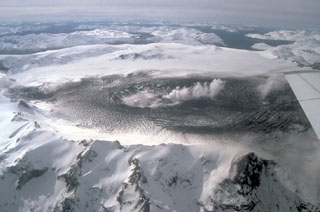Report on Cerro Hudson (Chile) — October 1991
Bulletin of the Global Volcanism Network, vol. 16, no. 10 (October 1991)
Managing Editor: Lindsay McClelland.
Cerro Hudson (Chile) Eruption impact on livestock described
Please cite this report as:
Global Volcanism Program, 1991. Report on Cerro Hudson (Chile) (McClelland, L., ed.). Bulletin of the Global Volcanism Network, 16:10. Smithsonian Institution. https://doi.org/10.5479/si.GVP.BGVN199110-358057
Cerro Hudson
Chile
45.9°S, 72.97°W; summit elev. 1905 m
All times are local (unless otherwise noted)
The following report about the effects of ash from Hudson's 12-15 August eruption on livestock is from the U.S. Centers for Disease Control.
"Large numbers of livestock deaths were reported in Santa Cruz province, Argentina, in the weeks immediately following the initial eruptions of Hudson. In response to reports that large numbers of sheep deaths were due to high fluoride levels from ash, an investigation was conducted by U.S. Centers for Disease Control personnel in cooperation with the Office of Foreign Disaster Assistance.
"Analysis of sheep urine and ash samples collected between 17 and 22 September revealed low levels of fluoride. Mean fluoride urine levels of 5.7 mg/L fall within the normal range for ruminants. Preliminary fluoride analyses on ash samples collected at different distances from Hudson were performed both before and after rainfall. Ion chromatography using acetic acid extraction revealed fluoride levels ranging from nondetectable to 14 ppm in the samples collected 17-20 September. Although this ash analysis is preliminary, the results indicate that fluoride levels in these samples are well below toxic concentrations. The maximally tolerable range for fluoride concentrations in ruminant feed is between 40 and 50 ppm.
"These results, in combination with clinical impressions, lead to the conclusion that a great many of the sheep deaths are possibly due to a complex set of environmental, topographical, and husbandry conditions that were exacerbated by the presence of large amounts of volcanic ash. The sheep in Santa Cruz had just survived a particularly harsh winter and were going into the spring lambing season feeding on overgrazed land that had undergone a period of prolonged drought. Pregnant ewes are typically very susceptible to toxemia late in gestation and the unavailability of food and water due to ashcover for even a short period of time is sufficient to trigger this often fatal condition. Clinical observations of sheep deaths in the area of volcano ashfall are consistent with death due to complications of pregnancy, greatly exacerbated by the physical presence of ash. Pregnancy toxemia is a condition with a very poor prognosis and no easy and certain treatment."
Geological Summary. The ice-filled, 10-km-wide caldera of Cerro Hudson volcano was not recognized until its first 20th-century eruption in 1971. It is the southernmost volcano in the Chilean Andes, related to subduction of the Nazca plate beneath the South American plate. The massive volcano covers an area of 300 km2. The compound caldera is drained through a breach on its NW rim, which has been the source of mudflows down the Río de Los Huemeles. Two cinder cones occur N of the volcano and others occupy the SW and SE flanks. This volcano has been the source of several major Holocene explosive eruptions. An eruption about 6,700 years ago was one of the largest known in the southern Andes during the Holocene; another eruption about 3,600 years ago also produced more than 10 km3 of tephra. An eruption in 1991 formed a new 800-m-wide crater in the SW portion of the caldera.
Information Contacts: C. Rubin and E. Noji, Centers for Disease Control, Atlanta.

